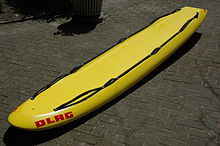Rescue board
A life board is a rescue device, similar to a surfboard , which is often used in water rescue . It is mainly used in inland waters or on the coast . It is usually not suitable for swimming pools because of its size and the limited space in a swimming pool. Depending on the distance, experienced lifeguards can get to the patient faster with the life board than with a rowboat . At a short distance it is often even faster than a motor lifeboat .
construction
The lifeboat is usually a little more than three meters long and less than a meter wide, so that two people can lie or kneel on it one behind the other. Unlike a surfboard, it has no means of securing a sail or foot straps. On the underside of the life board, however, there is a small plastic fin in the rear area of the newer boards, which stabilizes the board when moving, similar to a surfboard.
Some boards are also equipped with retaining straps. If the person seeking help is simply exhausted, he can support the rescuer by holding onto the straps. If, on the other hand, he is unconscious, the rescuer can hook the patient's hands or feet onto these straps and thus ensure that the person to be rescued does not slip off the board. A comparatively large amount of practice is required for this application.
Since the board is rather unwieldy to transport outside of the water, it is usually only available from fixed starting points on the water.
When the waves are strong, motor lifeboats or jet skis are more likely to be used because of the risk to the rescuer .
Possible uses
The rescue board is useful for the unconscious as well as for patients who are conscious. If no stretcher is available, the board can also be used as a stretcher in an emergency.
The rescuer moves to the patient lying down or kneeling exclusively with arm strokes. The feet can be in the water for stabilization or stretched sideways back over the board. During the arrival at the patient, the underside of the board is tilted upwards, the upper arms of the casualty are gripped and placed over them. The rescuer holds one arm of the patient on the board with one hand. Using leverage, the patient is lifted onto the board with the upper body and the board is turned to the right side. It is then turned lengthways and brought ashore. Since the rescuer can lie on the board behind him, the patient can always be observed.
In addition to the possibilities in the event of an emergency, many lifeguards also use the board to monitor swimming activity on the water side.
Significance in rescue sports
In rescue sports , the rescue board is used under the designation "Rescue Board" or "Malibu Board" in various open water disciplines. In the "Board Race", the competitors start with the rescue board at the water's edge and complete a circular course of approx. 500 m. Teams of two start in the "Rescue Board Rescue Race". The first competitor swims to a buoy after the start signal. The second then starts with the rescue board and picks up the swimmer. Both paddle back to the goal on the board. The all-around competition "Oceanman / Oceanwoman" also includes a board race.

